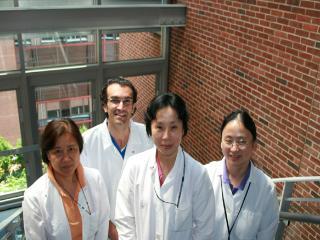contact
Sierra Jackson
Administrative Coordinator
F 410-706-7201
Admissions
Phone: 410-706-4469
Email: Admissions
Web: www.dental.umaryland.edu/admissions/
Research Program
Dr. Masri's Research Interests

My interest in the pain-neuroscience research started when I was a dental resident seeking a certificate in prosthodontics. I treated many patients with orofacial muscle pain/temporomandibular joint disorders, and I was always dismayed by the lack of understanding for the etiology of these disorders and the lack of effective treatments. This led me to pursue a career with a special emphasis on studying the neurobiological basis of chronic pain.
Early on in my career, I used electrophysiological, behavioral, and histological approaches to investigate how orofacial muscle pain affects sensory motor interactions in the brain stem. Then, as a postdoctoral fellow, I continued to study the trigeminal system and investigated research questions relating to the processing of somatosensory and noxious trigeminal inputs in thalamic and cortical regions. I received support through a T32 mechanism for long-term faculty training. It allowed me to continue studying thalamocortical pain circuits in the context of chronic pain and provided me with the opportunity to cement my place as an independent investigator. As a principal investigator, I was able to attract funding from the NIH through the R01 and the R21 mechanisms, as well as from the Department of defense (DoD).
My research interests are not limited to conditions that afflict the orofacial region, but also cover conditions such as neuropathic pain due to spinal cord injury and traumatic nerve injury. I utilize a wide array of approaches to test hypotheses and to interrogate circuits including electrophysiological, behavioral, and histological techniques. My laboratory also employs optogenetic and chemogenetic manipulations, in vivo calcium imaging, protein analysis, and advanced functional magnetic resonance imaging techniques on routine basis.
The following is a summary of contribution to research and science in the last 15 years.
(1) Mechanisms of central neuropathic pain
Central pain is chronic pain due to injury of the central nervous system. The pain is severe, unrelenting and refractory to conventional pharmacologic treatment. Despite extensive research and advancements in the field, several aspects of the neural mechanisms underlying the pathophysiology of central pain remain unresolved. It was proposed, more than a century ago, that central pain results from abnormal inhibition within the thalamus. However, the source of this inhibition, the specific nuclei affected, and how it results in central pain is unclear.
Research in my laboratory, in collaboration with Dr. Asaf Keller, focused on this hypothesis. Using electrophysiological recordings in animals, we identified, for the first time, a novel circuitry that potently regulates the flow of nociceptive information in the thalamus. In this circuitry, the zona incerta (an inhibitory subthalamic nucleus) potently inhibits higher order thalamic nuclei and suppresses the flow of nociceptive information from the thalamus to the cortex. We demonstrated, in experimental central pain conditions, that inhibitory control from the zona incerta is abnormal, which results in disinhibition of higher order thalamic nuclei and the perception of pain.
This finding also led us to discover a potential mechanism to produce analgesia and ameliorate central neuropathic pain. It is well established that the zona incerta receives dense excitatory projections from the motor cortex. Thus, we proposed that stimulation of the motor cortex could activate zona incerta and enhance inhibition in the thalamus. Enhanced inhibition in the thalamus would ameliorate central pain. Indeed, our findings supported this hypothesis. My laboratory continues to study mechanism of central pain and methods to ameliorate this painful condition with special emphasis on abnormalities in thalamic and cortical areas.
(2) Orofacial muscle pain and proprioception
Several hypotheses have been proposed to explain the pathophysiology of orofacial muscle pain. The most prominent is the vicious cycle theory, proposed in the 1940s by Janet Travell, and the pain-adaptation model proposed by Jim Lund and Christian Stohler in the 1990s. A major limitation of both of these theories is that they do not explain poor coordination of jaw movements and poor interdental discrimination in patients with orofacial muscle pain.
My PhD dissertation, under the mentorship of Dr. Norman Capra, focused on studying these critical questions. I used an animal model of orofacial muscle pain and recorded activity of trigeminal muscle spindle afferents in response to experimental muscle pain. I discovered that orofacial muscle pain alters the activity and sensitivity of muscle spindle afferents by modulating gamma-motor neuron activity. In addition to describing this phenomenon, I also performed experiments to illustrate the circuitry involved. My work demonstrated the presence of an indirect pathway connecting Group III and IV muscle afferents (nociceptive inputs) and trigeminal-gamma motor neurons, a pathway not described previously.
(3) Innovative treatment for dental pulp pain
In dentistry, available treatments for pulpal inflammation and pulpal pain are limited. They either involve a root canal treatment of the dental pulp in cases of irreversible pulpitis or the removal of involved tooth structures and filling of the tooth using a restorative material in cases of irreversible pulpitis. These treatment modalities are outdated and aggressive since they involve the removal and amputation of tooth structures. In collaboration with Dr. Didier Depireux at the University of Maryland College Park, we developed an innovative technology to treat pulpal inflammation and pulpal pain. In this technology, we exploit dentinal tubules to efficiently deliver nanoparticles-laden with therapeutic medications (e.g.: steroids, antibacterials). We actively steer these nanoparticles using strong magnetic forces that allow us to guide the particles from a cavity in the tooth to the tooth pulp through dentinal tubules. This technology can be used to reduce pulpal inflammation and tooth sensitivity. This technology can also improve the bonding of dental restorations to dentin. We obtained funding from the NIH to further develop this technology (see Support) and received the BioMaryland LIFE prize award. We are in the process of commercializing this technology.
